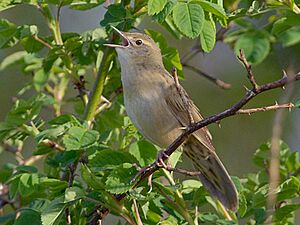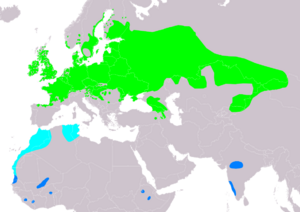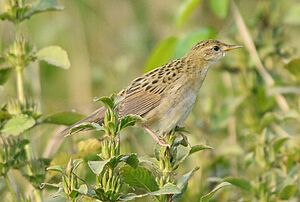Common grasshopper warbler facts for kids
The common grasshopper warbler (Locustella naevia) is a small bird that belongs to the group called Old World warblers. It lives in many parts of Europe and western Asia. This bird is a migratory species, meaning it travels long distances. It spends its winters in northern and western Africa.
This little passerine bird likes to live in short, thick plants, often near water. It is about 13 centimeters (5 inches) long. Adult birds have a streaky brown back and whitish-grey belly. Their undersides are plain, except for some streaks under their tail. Male and female birds look the same, which is common for warblers. However, young birds have a more yellowish belly. Like most warblers, it eats insects. It lays four to seven eggs in a nest built on or close to the ground, hidden in thick plants or a clump of grass.
This bird is very shy and hides in the bushes and low plants. It's hard to spot! You might only see it when it sings from a visible spot. Its song is how it got its name. It sounds like a constant, mechanical, insect-like buzzing or reeling sound. It often sings at dawn or dusk.
Quick facts for kids Common grasshopper warbler |
|
|---|---|
 |
|
| Conservation status | |
| Scientific classification | |
| Genus: |
Locustella
|
| Species: |
naevia
|
 |
|
| Range of L. naevia Breeding Passage Non-breeding | |
Contents
What's in a Name?
The common grasshopper warbler got its scientific name, Locustella naevia, from different naturalists over time. In 1783, a Dutch naturalist named Pieter Boddaert gave it the scientific name Motacilla naevia. He used the word naevia, which means "spotted" in Latin.
Later, in 1829, a German naturalist named Johann Jakob Kaup created the genus Locustella. The common grasshopper warbler became the main example for this group. The name Locustella comes from a Latin word meaning "grasshopper." This is because the bird's song sounds a lot like a grasshopper!
There are four main types, or subspecies, of the common grasshopper warbler:
- L. n. naevia: Found in Europe to western Russia and Ukraine. It spends winter in West Africa.
- L. n. straminea: Lives from eastern Russia to parts of Siberia, Kazakhstan, Mongolia, and China. It winters in South Asia.
- L. n. obscurior: Found in eastern Turkey and the Caucasus region.
- L. n. mongolica: Lives from Kazakhstan to Afghanistan and western Mongolia. It winters in northern India.
How to Spot a Grasshopper Warbler
The common grasshopper warbler is about 12.5 centimeters (5 inches) long. It's a very shy bird, so it's hard to see. But you can easily tell it's around because of its special song!
Its upper body is a pale olive-brown color. Each feather has a darker brown streak in the middle. Its cheeks are greyish, and its eyes are brown with a faint streak behind them. The top part of its beak is dark brown, and the bottom part is yellowish-brown. Its belly is creamy or yellowish-buff, with a few dark brown spots and streaks on its chest and sides. Its wings are brown, with lighter brown edges on the feathers. The tail feathers are reddish-brown, sometimes with faint stripes. The feathers under its tail are streaked. Its thin legs and feet are pale yellowish-brown.
The Unique Song
The song of the common grasshopper warbler is a long, high-pitched, buzzing sound. It's not very musical. The bird sings with its beak wide open, and its whole body vibrates! The song can last from a few seconds to two or three minutes without much of a break. It can be a quiet hum or sound like a distant lawnmower. You can hear it at any time of day, from early morning until after sunset. It sings constantly from when it arrives in spring until late July. When it's alarmed, it makes a repeated ticking sound, like "twkit-twkit-twkit."
Where They Live
The common grasshopper warbler breeds in northwest Europe and western Asia. You can find it in countries like Spain, France, Italy, Germany, the British Isles, and parts of Russia. Further east, other similar species live. In late summer, these birds fly to northwest Africa, India, and Sri Lanka to spend the winter.
During the breeding season, the common grasshopper warbler likes damp or dry places with tall grass and bushes. This includes the edges of wet areas, clearings in forests, old hedgerows, heaths, and young tree plantations. In winter, it usually lives in similar places, but we don't know as much about its behavior then.
Daily Life of a Warbler
This bird rarely flies high. Instead, it spends its time moving quickly through thick plants. It flits from twig to twig or runs along the ground. It has a special way of walking, with high steps and long strides, as it moves along horizontal branches. It looks thin and tapered. When it lands, it often raises and spreads its tail to show the streaked feathers underneath. Sometimes, it might pretend to be hurt to distract a predator.
Building a Family
Male common grasshopper warblers try to attract females by showing off. They walk or run along twigs with their tail spread out. They flutter their wings up and down, often carrying a piece of grass or a leaf in their beak. When flying, they spread their tail and fluff their feathers.
Both male and female birds help build the nest. The nest is well-hidden and built close to the ground. It can be in clumps of grass, gorse bushes, or tangled hedgerows. The nest is made of grasses, sedges, and mosses, and often lined with fine grasses.
A female lays four to six eggs. They are creamy white with small reddish spots. These spots are usually spread out, but sometimes they join together. The eggs are about 18 by 14 millimeters (0.7 by 0.55 inches) and weigh about 1.7 grams (0.06 ounces). Both parents take turns incubating the eggs, which takes about fourteen days. The baby birds are born helpless and are fed insects by their parents. They leave the nest in twelve to thirteen days. Usually, there are two groups of babies each season. Young birds can have their own babies when they are one year old. The oldest common grasshopper warbler ever recorded lived for five years.
What's for Dinner?
The common grasshopper warbler is an insect-eater. It eats many different kinds of small creatures without backbones. Its diet includes flies, moths, beetles, aphids, dragonflies, and mayflies, as well as their young (larvae). Spiders and woodlice are also on the menu. Baby birds are fed aphids, green caterpillars, woodlice, and flies.
How They're Doing
The IUCN (International Union for Conservation of Nature) says the common grasshopper warbler is of Least Concern. This means it's not currently in danger of disappearing. This is because there are many of these birds, and they live in a very large area.
In Europe, there are an estimated 840,000 to 2.2 million breeding pairs. This means there are between 2.5 and 6.6 million individual birds. Since Europe makes up about two-thirds of their total range, the world population is thought to be between 3.4 and 13.2 million birds. The total number of birds might be going down because they are losing their homes (habitat loss). However, this decline is not big enough to put the bird in a higher risk category.
Scientists have studied how climate change might affect birds. They believe that the common grasshopper warbler's breeding range could move several hundred miles north. This means they might start breeding in the British Isles and all of Scandinavia, but they might stop breeding in many parts of mainland Europe where they live now.




